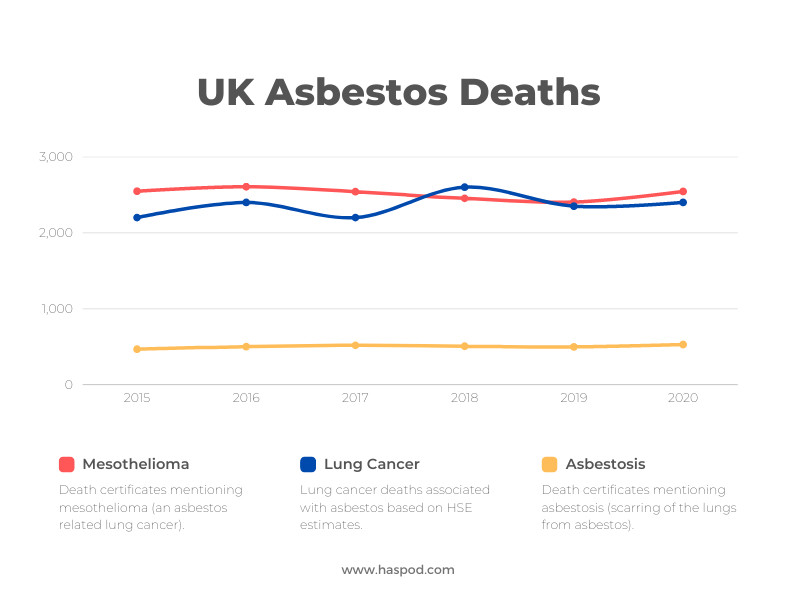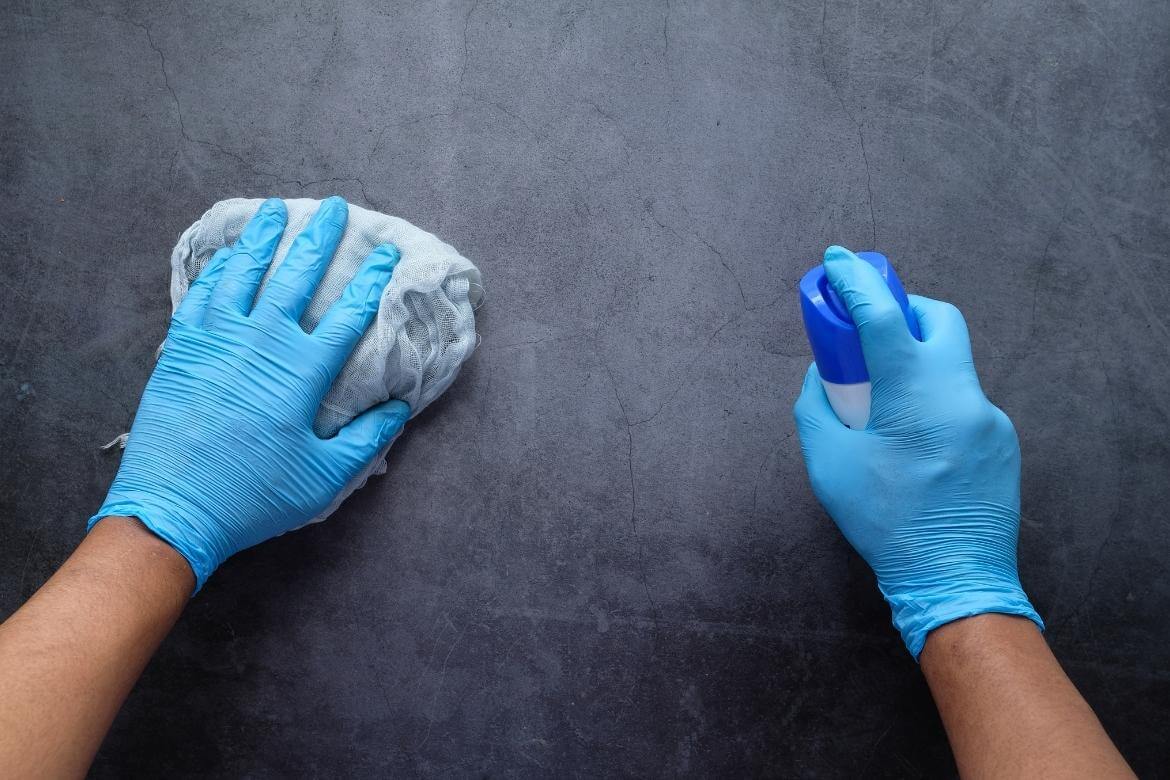3rd November, 2022
The Top 5 Health Risks At Work (From HSE Statistics)
1.7 million workers are suffering from work-related ill health, with over half a million new cases each year. Work-related ill health is responsible for a staggering 32.5 million working days lost. Not to mention the pain and suffering of those affected. Here are the top 5 causes.

Safety hazards often hit the headlines. Fatal accidents and major incidents are shocking and attract attention. But what about the "health", in health and safety? The figures relating to work-related ill health can be even more startling.
HSE statistics show that 1.7 million workers are suffering from work-related ill health in 2020/21. That's an increase of 300,000 people since 17/18.
With over half a million new cases each year, work-related ill health is responsible for a staggering 32.5 million working days lost annually - not to mention the pain and suffering of those affected.
The majority of work-related deaths aren't from safety failings but health problems. Some diseases take years - even decades - to develop. They might not kill you immediately, but these deaths are work-related nonetheless. In fact, the HSE estimates that 13,000 deaths each year are linked to past exposure at work.
13,000 Deaths each year estimated to be linked to past exposure at work, primarily to chemicals or dust.
Compare this to 142 fatal injuries to workers in the same year, and you can see why health risks should also be a key focus for every business.
1. Asbestos
Asbestos is number 1 on our list because it is responsible for the most deaths each year. The HSE estimate that there are around 5000 deaths each year in the UK due to past asbestos exposure.

Around half the estimated 5000 asbestos deaths are from mesothelioma, which is an asbestos-related cancer of the lining of the lungs. And a further 2,500 deaths from asbestos-related lung cancer in the cells of the lungs.
Asbestos is banned in the UK now, but asbestos got used in loads of building products before the ban in 1999. Heavy use of this naturally occurring material in the past means it's still found in hundreds of thousands of buildings.
Many people think that asbestos is a health risk only affecting construction workers - and that is mostly true. However, anyone can be at risk. Teachers have been known to be exposed by using drawing pins on walls. Families have been exposed to workers carrying fibres home on their clothing.
In the last 10 years, according to HSE statistics, there have been over 24,000 deaths where mesothelioma was diagnosed. Around 20,000 men, and 4,000 women. Women are not at less of a risk. The big skew is because construction is a male-dominated industry, and this is the most at-risk sector.
Want to know more? Download the asbestos awareness toolbox talk for more information.
2. Mental Health
We knew mental health would be in our top 5 but expected it to be lower down the list. However, the HSE statistics show that this is a major contributor to work-related ill health.
A massive 17.9 million working days were lost due to work-related mental health issues (stress, depression or anxiety) in 2019/20. And this looks to be on the increase and the number of workers suffering from new cases increased from 347,000 (19/20) to 451,000 (20/21).
822,000 workers suffering from work-related stress, depression or anxiety (new or long-standing) in 2020/21.
If you need help reducing stress triggers in the workplace, check out these 24 tips for reducing stress at work.
3. Manual Handling
Musculoskeletal disorders affected just under half a million workers in 20/21. The biggest contributor? Manual handling.
470,000 workers suffering from work-related musculoskeletal disorders (new or longstanding) in 2020/21.
It might not seem like lifting and carrying can be a major health risk, but as HSE statistics show, it is.

Carrying things that are too heavy, or bulky, can lead to stress and strain on the body. Your weakest point is usually your back, but shoulders, arms, hands and legs can all be affected. And, it's not always what you carry, but also how you carry (or lift). Sometimes, simply making sure you have the right posture and correct manual handling technique can prevent injury.
Manual handling problems at work? Remember to think LITE!
4. Silica Dust
Silica dust is another big health risk that primarily affects construction workers. It's made it into the top 5 because - like asbestos - silica dust exposure can be fatal.
The HSE estimate that around 17% of occupational cancer cases can be attributed to past exposure to silica dust. That's around 850 new diagnoses, and 629 deaths each year.
It is estimated that past exposures in the construction sector annually cause over 5,000 occupational cancer cases and approximately 3,700 deaths.
Silica dust can be found in a wide variety of construction materials. Concrete, limestone, granite, slate, brick - all these materials contain silica. And on construction sites, these are materials that regularly need to be cut to size, drilled and worked on, releasing hazardous dust into the air.

Silica dust might not be talked about as much as asbestos, but the impact can be just as devastating to those affected.
Be aware of the risks. Download the silica dust toolbox talk and start a conversation.
5. Hazardous Substances
We have already covered two hazardous substances in our top 5, asbestos and silica dust. These are major workplace killers but don't think they are the only ones.
Chemicals, lead, and other hazardous substances are health risks too. Even wood dust can cause certain types of cancer. HSE statistics for 2020/21 show that there were around 12,000 work-related lung disease deaths. Over 50% of these were not asbestos-related.
17,000 new cases of breathing or lung problems caused or made worse by work each year on average over the last three years.
Hazardous substances don't just cause respiratory problems. They can also cause skin issues, like dermatitis. Some hazardous substances can be toxic to internal organs or cause other conditions, like birth defects.

It's important to know what hazardous substances you work with. Some substances will have workplace exposure limits (WELs), and others will need to have their risks minimised as far as is reasonably practicable. Remember, the COSHH regulations apply to all hazardous substances.
Keep a list of all the hazardous substances in your workplace, with the free COSHH register template.
In 2020/21 due to the coronavirus pandemic no new data on working days lost and economic costs are available, where applicable we have referred back to 19/20 for this information.
This article was written by Emma at HASpod. Emma has over 10 years experience in health and safety and BSc (Hons) Construction Management. She is NEBOSH qualified and Tech IOSH.
Need health and safety documents?
Search hundreds of health and safety documents ready to edit and download for your business.
Find DocumentsRecent posts like this...

You're As Cold As Ice, Don't Be Willing To Sacrifice (Your Health And Safety)
With temperatures often hitting the minuses at this time of year (yes, more freezing than freezing), it's important to remember that when you're as cold as ice, extra consideration should be given to health and safety.
Read Post
Remember, Remember, Your Health This November!
Health often takes a back seat when it comes to health and safety. But last year there was triple the number of ill-health cases compared to injuries at work (1.8 million ill-health cases reported, 0.6 million injuries). So remember, remember, your health this November!
Read Post
The Noise At Work Action Levels And Legal Limits
The law requires employers to protect the hearing of their workers. The Control of Noise at Work Regulations specify legal limits regarding noise levels and requires you to take action when the noise gets too loud. Let's look at the legal limits for noise at work.
Read Post